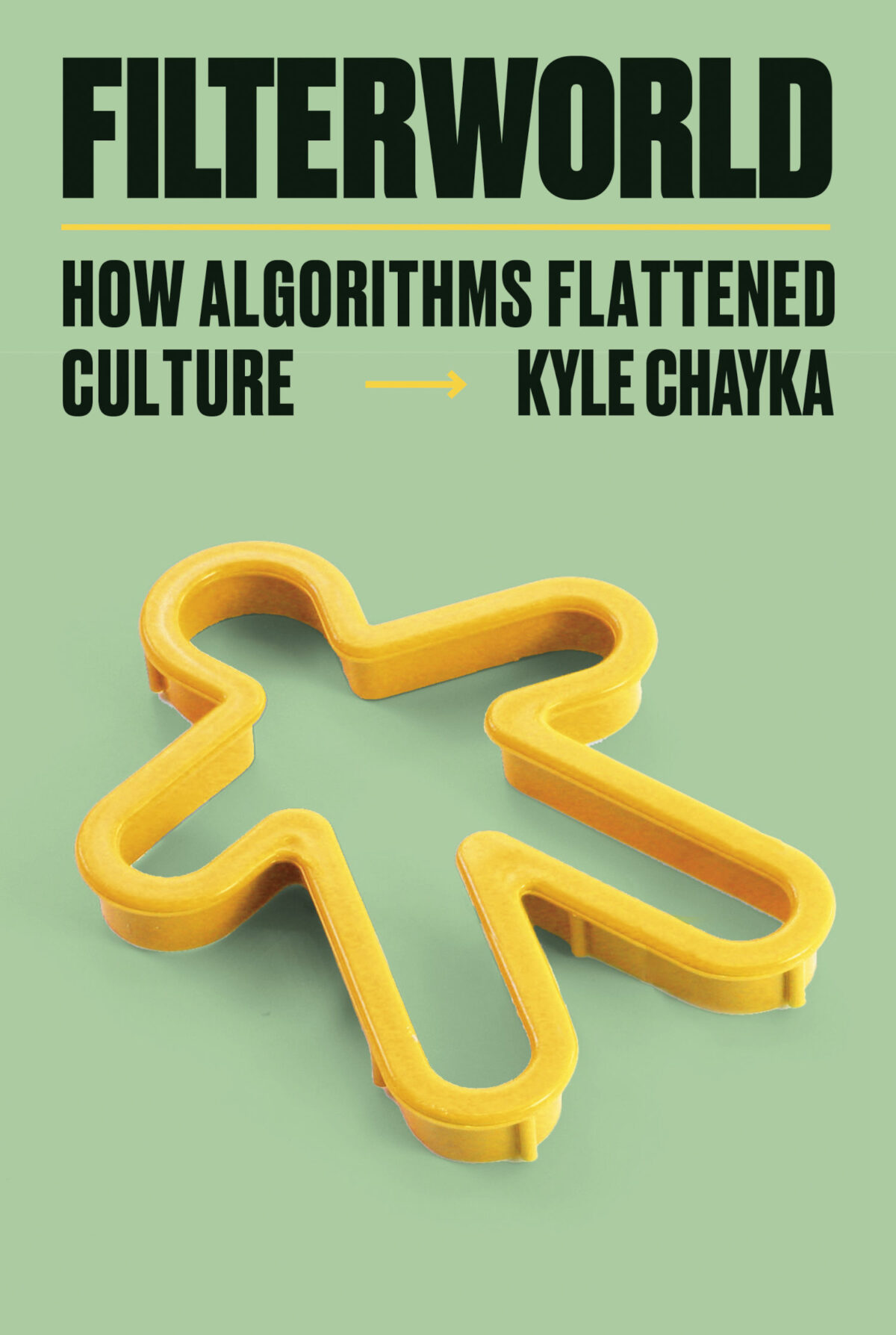About a decade ago, the anthropologist Natasha Dow Schüll — who’d spent years studying casino slot players — popularized a cycle of repeated engagement she called the “ludic loop.” Each time people pull a slot lever and watch the fruits align, they get a hit of rewarding brain chemicals that entices them to pull the lever again and again. Though alluring, the ludic loop is also fundamentally hollow: People emerge from it anesthetized and depleted, having gained nothing in the end.
The ludic loop concept predated the reign of “the algorithm” — the stretches of computer code that dictate which new content rolls onto our social media feeds, playlists, and streaming services. Yet Schülll’s theory anticipated how millions of users would engage with content streams tailored to their desires — passively, almost thoughtlessly, ever seeking the next dopamine hit.

BOOK REVIEW — “Filterworld: How Algorithms Flattened Culture,” by Kyle Chayka (Doubleday, 304 pages).
In “Filterworld: How Algorithms Flattened Culture,” Kyle Chayka, a writer for The New Yorker, argues that the programs and apps serving up this addictive content have bled art and culture dry. By promoting creators who churn out attention-friendly “most liked” material, and lulling us into hoovering it up, algorithms highlight “the least ambiguous, least disruptive, and perhaps least meaningful pieces of culture,” Chayka writes. The result, he contends, is as empty as the ludic loop itself: content that “embraces nothingness, that blankets and soothes rather than challenges or surprises, as powerful artwork is meant to do.”
Scientists have long known that our brains are geared toward meme-making. We replicate and pass along concepts and ideas we like — which explains why tribes developed distinctive beadwork styles, or why Impressionist painters all adopted similar line-blurring brushstrokes. But algorithms have intensified and globalized this meme-making process by relentlessly promoting what’s most engaging, a trend Chayka traces to scientists’ early ideas about how to filter the deluge of online content. “We need technology to help us wade through all the information to find the items we really want and need,” MIT Media Lab researchers wrote in 1995, “and to rid us of the things we do not want to be bothered with.”
Yet that proposal has reaped unforeseen consequences. There’s a reason cafes from London to Reykjavik to Beijing all feature subway tile walls, reclaimed wood, and Edison-bulb lighting: After Instagram algorithms served many business owners the same most-liked content, “one cafe owner’s personal taste would drift toward what the rest of them liked too,” Chayka writes, “eventually coalescing into a net average.”
It’s this predictable coalescing, this regression to a bland common denominator, that Chayka finds corrosive. While rubber-stamped cafe interiors are largely harmless, other algorithm-driven content has a more insidious effect: It hypnotizes viewers and courts likes but makes scarcely any lasting impression. “When it’s over,” Chayka writes, “the experience immediately leaves your mind like the bubbles effervescing in seltzer.” For Filterworld’s deep-pocketed feed managers, the ideal user experience is the frictionless plane, the better to ease the way to more content consumption.
Algorithms highlight “the least ambiguous, least disruptive, and perhaps least meaningful pieces of culture,” Chayka writes.
Though most people sense the seltzer-bubble vapidity in what their feeds serve up, what’s harder to grasp is how algorithms shape the act of creation itself. Chayka deftly explains the complex incentives that guide artists in the algorithmic era — and how some of these forces act on them without their awareness. Because “Insta-poets” get the most online engagement with brief, simple verse, some now write such verse almost exclusively, while visual artists veer toward inoffensive, bright-colored sketches. (All the while, they remain in the dark about how social networks dictate what gets widely distributed, a state Rutgers computer scientist Shagun Jhaver calls “algorithmic anxiety.”)
By promoting what accrues likes rather than more challenging fare, algorithms are devaluing content that has the power to disturb us and upend our assumptions, Chayka writes. “We miss out on culture that is truly progressive and uncomfortable.”
To feed the social media beast is to recognize this pruning at work. Selfies and family snaps can rack up high like counts and views, but disturbing photos, like a swastika scratched on a food court wall, may get much less traction. (People don’t want to like them, after all.) And blatant misinformation, like claims that ivermectin cures Covid-19, can dominate feeds if it reconfirms viewers’ priors (say, that out-of-the-box remedies trump established ones).
The book’s final chapters focus on how to preserve art and culture’s power to challenge us in the algorithmic era. In the face of our relentless numbness to so much — racism, authoritarianism, genocide — Chayka’s appeal for constructive friction feels crucial, if a bit quixotic. Some cultural creations, in the tradition of Elie Wiesel’s “Night,” ought to be warnings: not all-caps screeds that fuel angry engagement, but bone-deep auguries that linger past the next ping or refresh.
Yet Chayka’s proposals for reviving this dynamic are incomplete. He recommends seeking out human curators beyond the internet, in places like art museums and movie theaters, who highlight boundary-breaking art and deepen our appreciation of it. These curators “make sure that what merits exposure gets it,” he writes, “and introduce us to what’s new, challenging us enough that we avoid homogeneity.”
While this advice is sound enough in itself, it glosses over the contributions of shrewd online curators who operate within algorithmic confines. Instagrammer Mimi the Music Blogger, for instance, has her ear to the ground in the rap community, allowing her to feature cutting-edge artists her followers may never have encountered. Since subversion sometimes does come nested in feeds, the way forward may involve finding and supporting creators that embrace it, rather than opting out of Filterworld.
Though most people sense the seltzer-bubble vapidity in what their feeds serve up, what’s harder to grasp is how algorithms shape the act of creation itself.
At the same time, it’s hard not to wonder whether the algorithmic dominance Chayka so vividly describes is starting to ebb. There’s plenty of evidence that social media fatigue has mounted and that fewer posters now feed the kinds of content streams that draw eyeballs. Leaving Twitter’s (now X’s) chaos and Instagram’s airbrushed scenes behind, many of us are gravitating toward old-school online forums or semi-private spaces like Slack, where recommendations and cultural debates can thrive unfiltered.
Ultimately, though, “Filterworld” is about something bigger than social media or tailored feeds. It’s about our tendency to passively consume what’s spoon-fed to us — and our obligation to push back on that tendency, to seek out art that splits us open like Franz Kafka’s frozen axe.
“I’m operating on the belief,” writer Tracy K. Smith once said, “that poetry can restore me to the large original self I haven’t yet learned to fully recognize.” There is more than one route to that large original self, and some of those routes may be digital. But Chayka’s call to break out of hypnotic content loops — to reject the empty absorption of the slot jockey pulling the lever — resonates no matter the medium.












After my Parkinsons Disease diagnosis, my neurologist was very open when looking at alternative medicines and procedures, with his guidance i started on natural PARKINSONS DISEASE TREATMENT from Natural Herbs Centre. The treatment worked very effectively for my Parkinson’s, most of my severe symptoms simply vanished within the first 3 months on the treatment, i feel better now than I have felt in years and i can feel my strength again.